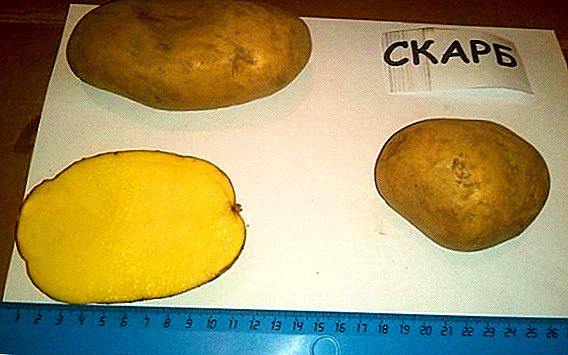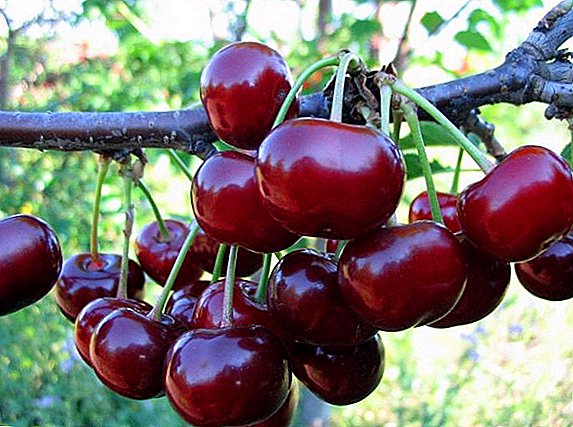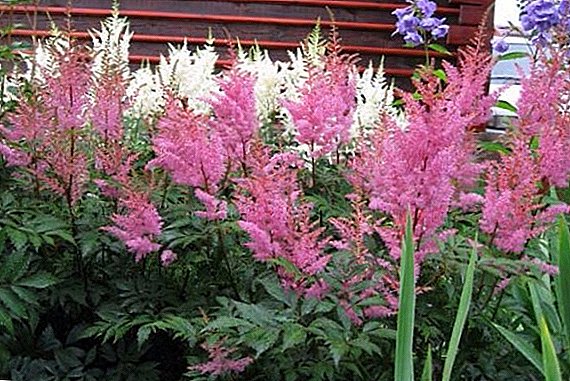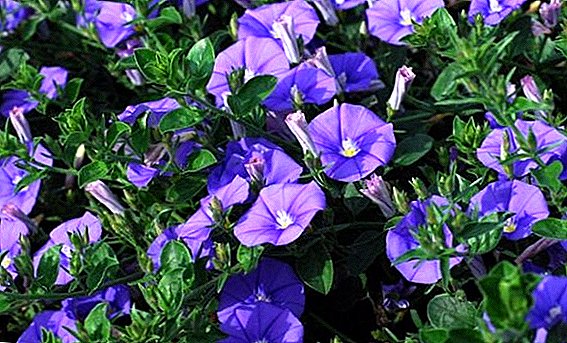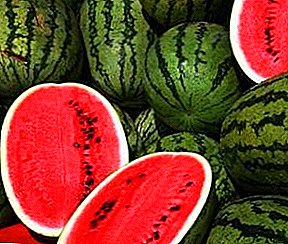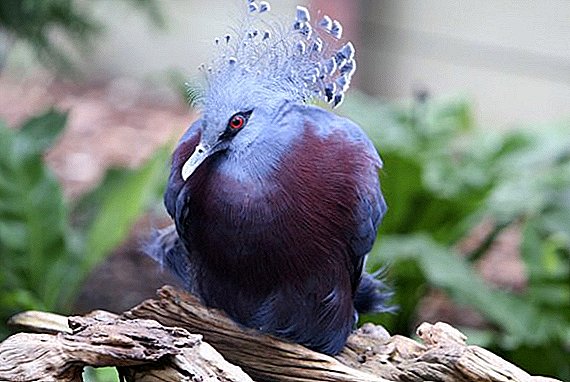 With the development of technology, it is becoming easier to keep in captivity various exotic species of animals and birds. The presence of such opportunities substantially heats the interest of poultry houses and livestock breeders to the latter. Crowned pigeons are completely unsuited for survival in our climatic and geographic conditions in natural form, however with the help of some tricks it is still possible to achieve successful breeding of these birds. In this article we will talk more about this breed.
With the development of technology, it is becoming easier to keep in captivity various exotic species of animals and birds. The presence of such opportunities substantially heats the interest of poultry houses and livestock breeders to the latter. Crowned pigeons are completely unsuited for survival in our climatic and geographic conditions in natural form, however with the help of some tricks it is still possible to achieve successful breeding of these birds. In this article we will talk more about this breed.
Description
First of all, for a person who has decided to start breeding the above birds, it will be important to learn how this type of pigeons can be distinguished from their less famous brethren. This will avoid possible various troubles and fraud on the part of sellers at the stage of buying a pair of these birds. Below we give an approximate description of the appearance of crowned pigeons, as well as their characteristic behavioral patterns.
Did you know? It is sometimes almost impossible to distinguish a crowned dove from a male of this species! The only reliable sign of belonging to the male sex in these birds is the product of specific enticing sounds at the stage preceding reproduction.
Appearance and physique
The most impressive dignity and the main reason why you should get these birds is their extraordinary, bright appearance. It varies slightly depending on the particular type of pigeon, but in general the birds look something like this:
- torso. Trapezoidal shape, elegant and light, does not have a pronounced muscular system, creates the impression of smoothness and streamline, covered with short, fluffy feathers ,;
- neck. Short, thin, elegant, smoothly connects the head with the body, in a calm state is located strictly perpendicular to the ground;
- head. Very small, neat, spherical shape, always directed strictly parallel to the ground, the occipital part is somewhat flattened;
- wings. Strong, massive and well developed, covered with particularly dense feathers, emitting a waxy substance, the color of which may be slightly darker than the color of feathers covering the body;
- eyes. Small sizes, expressive, round, often red shades, around the eyes there may be some kind of range of feathers, differing in color from the main color;
- beak. The beaks of other pigeons, of elongated pyramidal shape, are strong in size, strong, somewhat dulled at the end; at the base are neat, round nostrils;
- crest In its form, it resembles a kind of lace fabric, consists of a set of feathers, each of which has a triangular tassel at the end and rare, symmetric fibers along the entire length, diameter - 5-9 centimeters;
- tail. It is well developed, covered with 16-18 long, dense steering feathers, wide, rather long, may have a slight rounding at the end, in a restful state adjacent to the body at an angle of 5-10 °;
- coloring. Always bright and pleasant, can vary depending on the specific species of the pigeon, usually violet, blue, blue, brown in various combinations, a small number of feathers of white shades are allowed.


Did you know? Crowned pigeons are endangered species. In their endemic habitats, these birds were almost completely exterminated, because people valued their unique beauty of plumage and tuft.
Character
These birds have a very good disposition and fair ingenuity, which is most likely due to the lack of natural enemies in the wild. They cannot be called shy, they calmly and without aggression refer to a person, with a formed habit they allow themselves to be taken in their arms, to demonstrate their appearance by playing with feathers, and sometimes even to pose for photography.  They almost always adhere to their daily lifestyle, and during the daytime they are predominantly searching for food or arranging a nest. With the onset of the mating season, they begin to devote most of their time to their partner or his search (in the event that the bird is young). Crowned pigeons, like swans, most often form pairs once and for all life.
They almost always adhere to their daily lifestyle, and during the daytime they are predominantly searching for food or arranging a nest. With the onset of the mating season, they begin to devote most of their time to their partner or his search (in the event that the bird is young). Crowned pigeons, like swans, most often form pairs once and for all life.
Discover the species and breeds of pigeons.
Young birds tend to stick together with other young and the aging generation that they watch over. Fertile-aged couples live a little more apart, but they still almost never leave the territory of the pack and never leave it for long.
This bird, despite its rather impressive wings, prefers to move on the ground or trees on foot, with the help of the paws. Flight is mainly used as a means of escaping danger or for migrating to a new habitat. In the wild, a favorite activity during the time not occupied with the search for food is sitting and swaying on the vines and branches of trees. 
Varieties of crowned pigeons
As mentioned earlier, there are several varieties of crowned pigeons, which vary quite slightly in their external parameters, but very significantly differ in their habitats, which never intersect each other. In total, there are three species of this bird in nature: blue-headed, fan-bearing and chestnut-breasted. Below we look at the distinctive features of each of them.
Read about breeding of fighting and meat pigeons.
Blue-crested
The largest representative of the crowned pigeon species, whose weight can reach up to 3 kg, and height - up to 80 cm. In the wild, it can be found only in the southern part of New Guinea. The main distinctive feature of the appearance of these birds is that their tuft has a bright, rich, blue tint, and there are no triangular tassels on it, crowning each of the feathers that form the tuft, which all other subspecies of this species of birds have. 
Fan
This subspecies, without a doubt, the most attractive of the three existing in its external parameters. Its endemic habitat zone is the northern outskirts of New Guinea and the islands adjacent to it - Yapen and Biak. A distinctive feature of this subspecies of pigeons is the crest, in form resembling an open fan, which is associated with a special shape and arrangement of feathers on the head. The size of this subspecies is also quite impressive: weight can reach up to 2.5 kg, and height - up to 73-75 cm. 
Chestnut chest
The species, whose representatives in the wild remained the least. It differs in rather small sizes in comparison with its brothers: the maximum weight reaches 2 kg, and the height does not exceed 70 cm. The main distinguishing feature in the exterior is brown or chestnut chest color, and also a rather rare and unpresentable tuft compared to other subspecies. Natural habitat - the central part of the island of New Guinea. 
Where dwells
As mentioned above, the main endemic zone for the distribution of these birds is New Guinea Island and several adjacent smaller islands. In addition, it is necessary to take into account that only those zones of islands that are covered with tropical forests are suitable for their life, since only there they can find food and shelter from the weather during the rainy season.
Check out the top ten most unusual breeds of pigeons.
The rapid pace of urbanization and deforestation affect the prevalence and abundance of crowned pigeons in an extremely negative way, since they are completely not adapted to life in urban environments. They cannot find food for themselves, materials for building nests, it is extremely difficult for them to rebuild their circadian rhythms taking into account the availability of round-the-clock lighting, so if civilization arrives at their place of residence, they either migrate to unoccupied territory or die over time.
They cannot find food for themselves, materials for building nests, it is extremely difficult for them to rebuild their circadian rhythms taking into account the availability of round-the-clock lighting, so if civilization arrives at their place of residence, they either migrate to unoccupied territory or die over time.
What to eat
Preferred for these birds is food of plant origin. With great pleasure they eat various tropical fruits growing on trees, berries, especially love seeds (sometimes they don't even peel the flesh, break it with their beak to get to the seeds and leave untouched), if you cannot find food that grows on the tree, they can start eating fruits lying on the ground.
It is useful to know what pigeons eat at home and how to feed pigeon chicks.
If it is impossible to find plant food, crowned pigeons may begin to crawl under the bark of trees, in order to get any larvae, snails, beetles or other insects, but despite this, they never seek food for themselves while digging into the ground. Do not disdain the food that people give them, very often even allow them to feed themselves with their hands. When a flock completely exhausts the food resources of the area on which it is based, it flies all the time to another, richer food.
Breeding
One of the most important aspects of the normal process of vital activity of the flock as a whole and its individual cells in the form of married couples is the process of reproduction. It should be noted that in crowned pigeons this natural cycle proceeds with some features that you must be aware of if you intend to breed such birds in captivity. Below we describe the most important of these features.
It should be noted that in crowned pigeons this natural cycle proceeds with some features that you must be aware of if you intend to breed such birds in captivity. Below we describe the most important of these features.
Pair formation
As already mentioned, crowned pigeons almost always create a couple once and for a lifetime, although there is a slight chance of establishing a new partner if the previous one died or lost the ability to reproduce. Spontaneous mating is preceded by mating rituals that take place only on the territory occupied by the pack, but at the same time, each of the young males can lure females only in their own small territory. The beginning of the breeding season is in autumn.
Important! The probability of forming a new pair after the death of the previous partner in females is an order of magnitude higher than that of the males, so don’t be in a hurry to get rid of the female who has lost her mate - perhaps she will still be able to serve you.
Each male slowly begins to woo his possessions, making sounds that resemble an irregular drumbeat. Young females fly over the entire flock of territory, listening to these sounds, and when they find a suitable male, they sit on the ground not far from him and start flirting with him. After that, they choose a place for the nest in the territory occupied by the male, and they incubate it for a very long time in order to show all other birds where their house will be located.  After this, the pairing process takes place, almost immediately after which the pair begins the process of creating a nest. The main work on the search for materials is performed by the male, while the female is primarily engaged in the direct formation of the nest.
After this, the pairing process takes place, almost immediately after which the pair begins the process of creating a nest. The main work on the search for materials is performed by the male, while the female is primarily engaged in the direct formation of the nest.
Read about the pairing of pigeons and the features of this process.
Despite their natural dislike for flying, they make their nests quite high - on average not less than 6-10 meters above the ground. At the end of the nest building, the female lays eggs in it and the process of hatching the offspring begins.
Hatching eggs
Most often, the dove lays only one egg, in some rare cases, two or three. Each of these eggs weighs about 70-80 g. The whole process of incubation takes an average of 28-30 days. Both parents are quite active at this stage of breeding offspring. In this case, the father of the family sits on eggs during the day, and the mother - at night. During this period, it is quite problematic to find pigeons, because immediately after they have had enough, they rush back to the nest.  Sometimes a couple makes a preventive flyby of the territory they occupy in order to make it clear to other birds that it is inhabited and that new nests cannot be built on it.
Sometimes a couple makes a preventive flyby of the territory they occupy in order to make it clear to other birds that it is inhabited and that new nests cannot be built on it.
Find out how many pigeons are sitting on eggs.
At this stage of breeding, the partners seek to spend as much time as possible together, try to bring each other various treats and look after each other in every way. Each dove tries to allocate its free time as rationally as possible so that in addition to searching for food, it also has time to fly around the territory of other couples and “talk” with other females.
Nursing care
After the hatching process is completed and the chicks are born, the male begins to spend much more time searching for various food for the dove, which must be constantly present next to the chicks.  In the first 3-7 days, the chicks feed exclusively to regurgitate directly into their oral cavity with semi-digested food from the mother's stomach. Sometimes, if the female needed to leave the nest somewhere, the mother of the family can take over the maternal functions.
In the first 3-7 days, the chicks feed exclusively to regurgitate directly into their oral cavity with semi-digested food from the mother's stomach. Sometimes, if the female needed to leave the nest somewhere, the mother of the family can take over the maternal functions.
Important! After the chicks go on a normal diet, they begin to show the first significant signs of independence: crawling, squeaking loudly, flapping their wings, etc. During this period, it is necessary to be especially attentive to the young stock, as the probability of falling out of the nest increases.The female very rarely allows herself to leave the nest, protects babies from falling from a height, and also constantly inspects the surrounding area for a potential threat.
 The main task of the male during this period, in addition to obtaining food for himself and the female, is the constant patrol of the territory occupied by his family in order to identify possible dangers and to inform other members of the pack that the territory is occupied.
The main task of the male during this period, in addition to obtaining food for himself and the female, is the constant patrol of the territory occupied by his family in order to identify possible dangers and to inform other members of the pack that the territory is occupied.A similar schedule with small variations lasts for the parent couple for 35-40 days, during which the chicks have a plumage, they make their first flight and learn from the females to feed themselves. The chicks continue to live near their parents for another 2 years.
Is it possible to breed in captivity
Breeding this type of pigeons in our climatic conditions is a rather troublesome, but quite realizable thing. First of all, to organize adequate conditions for the reproduction and residence of such birds, it is necessary to take care of their future habitat. It is necessary to organize a spacious (at least 10 square meters), heated (temperature should not fall below + 20 ° C), a closed enclosure.  These birds react rather badly to cold, because their natural habitat is completely devoid of any hints of coolness. Getting into a cold environment, they very quickly become ill with colds, which subsequently pass into bacterial infections and most often end in death. That is why they need such a warm aviary.
These birds react rather badly to cold, because their natural habitat is completely devoid of any hints of coolness. Getting into a cold environment, they very quickly become ill with colds, which subsequently pass into bacterial infections and most often end in death. That is why they need such a warm aviary.
In the room where the crowned pigeons will be kept, it is necessary to organize some kind of forest terrain. You can put a large, tall, branched snag or a tall tree trunk with a large number of branches, convenient for organizing a nest on it. Also at first, you should definitely take care to provide the necessary amount of building material for the nest.
We recommend to learn how to build dovecote, as well as make a feeding trough and drinker for pigeons with your own hands.
In captivity, mainly these birds prefer to eat a variety of cereals: millet, wheat, rice, rye, etc. Sometimes they can also be given a variety of seeds, peas, corn. Many nurseries also recommend occasionally feeding small portions of a variety of animal food, such as snails or meal worms, to pigeons.  So, we hope that you have learned all the aspects you are interested in regarding the crowned pigeons. Remember that the breeding of exotic animals and birds is not an easy and cheap occupation, but the benefit that can be obtained in the end, more than compensates for all the initial costs. In addition, if you approach the process with due love and care, you will gain useful and interesting experience, which you will probably be interested to share with other poultry farmers.
So, we hope that you have learned all the aspects you are interested in regarding the crowned pigeons. Remember that the breeding of exotic animals and birds is not an easy and cheap occupation, but the benefit that can be obtained in the end, more than compensates for all the initial costs. In addition, if you approach the process with due love and care, you will gain useful and interesting experience, which you will probably be interested to share with other poultry farmers.


